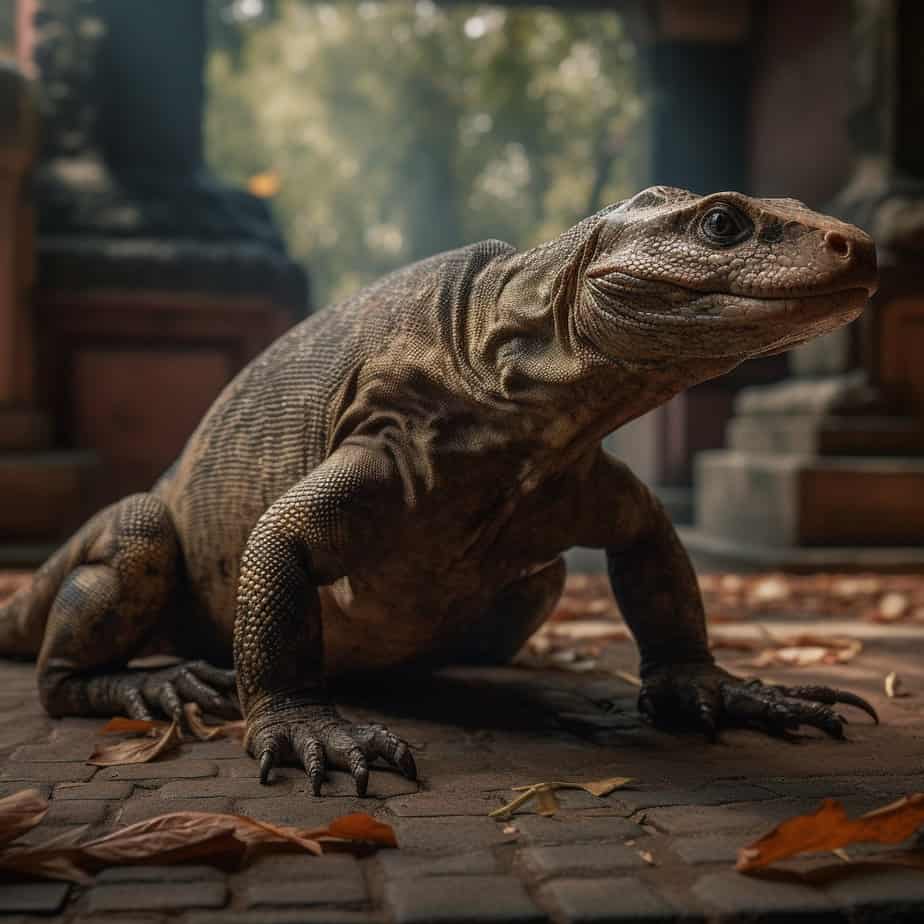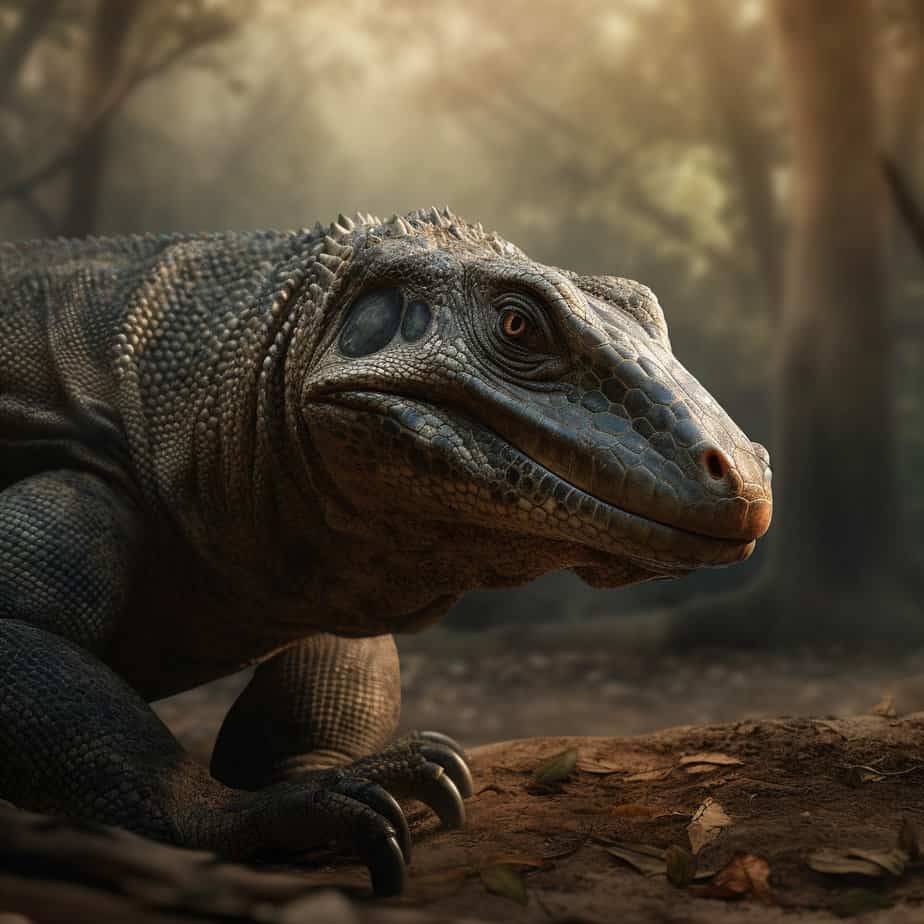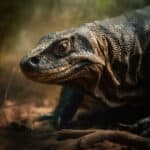The idea of having a Komodo dragon as a pet may seem intriguing to some, but it is important to understand the responsibilities and challenges that come with owning such a unique and powerful creature. Komodo dragons are the largest lizards in the world, known for their impressive size and fearsome reputation. Native to the Indonesian islands of Komodo, Rinca, Flores, Gili Motang, and Padar, these reptiles have captured the fascination of many people around the globe. However, it is crucial to note that Komodo dragons are wild animals and require specialized care, extensive knowledge, and proper permits to keep them legally. In this article, we will explore the various aspects of owning a Komodo dragon as a pet, including their habitat requirements, dietary needs, legal considerations, and the potential risks involved. So, if you’re curious about what it takes to have a Komodo dragon as a pet, read on to discover more about these magnificent creatures and the responsibilities that come with owning one.
Key Takeaways
- Keeping a Komodo dragon as a pet is not recommended due to their size, specialized care requirements, and potential danger.
- Komodo dragons are large, powerful predators that require a significant amount of space, specific diet, and expert handling.
- They are protected species and it is illegal to own them as pets in many countries.
- It is important to prioritize the well-being and conservation of these unique creatures by supporting efforts to protect their natural habitats.
The Fascination with Komodo Dragons

A. Understanding the Komodo Dragon: A Brief Overview
Komodo dragons, scientifically known as Varanus komodoensis, are fascinating creatures that have captured the imagination of people around the world. These large lizards are native to the Indonesian islands of Komodo, Rinca, Flores, Gili Motang, and Padar. They are the largest living species of lizard, growing up to 10 feet long and weighing over 150 pounds.
Komodo dragons have a unique appearance, with rough, scaly skin, powerful limbs, and a long, muscular tail. They are well-adapted predators, with sharp claws and serrated teeth that allow them to tear through their prey. Despite their massive size, they are surprisingly agile and can move quickly when hunting or defending their territory.
B. The Allure of Exotic Pets: Komodo Dragons in the Spotlight
Exotic pets have always held a certain allure for animal enthusiasts, and komodo dragons are no exception. These majestic creatures have become the subject of fascination for many people who are drawn to their beauty, power, and mystique. However, it’s important to note that keeping a komodo dragon as a pet is not a decision to be taken lightly.
While some reptile enthusiasts may be tempted to keep a komodo dragon as a pet, it’s crucial to understand the challenges and responsibilities that come with owning such a unique and potentially dangerous animal. Komodo dragons require specialized care, a suitable habitat, and a deep understanding of their behavior and needs.
One of the main reasons why komodo dragons are not commonly kept as pets is their size. These reptiles grow to be quite large, requiring a spacious enclosure that can accommodate their size and provide them with ample room to move around. Additionally, their diet consists mainly of meat, including small mammals, birds, and even other reptiles. Feeding a komodo dragon can be a complex task, as their nutritional needs must be met to ensure their health and well-being.
Another factor to consider is the legal aspect of owning a komodo dragon. In many countries, it is illegal to keep these reptiles as pets due to their protected status and the potential risks they pose to humans and other animals. It’s essential to research and understand the laws and regulations in your area before considering a komodo dragon as a pet.
Furthermore, komodo dragons have specific behavioral traits that may not make them suitable for domestication. They are solitary creatures that require a significant amount of space and solitude. Attempting to keep them in captivity can lead to stress and aggression, posing a risk to both the owner and the animal.
In conclusion, while the allure of owning a komodo dragon as a pet is understandable, it is crucial to consider the practicalities, legalities, and ethical implications of keeping such a unique and potentially dangerous animal. The responsible choice is to admire these magnificent creatures from a distance, in their natural habitat or in reputable zoological institutions where their needs can be properly met.
The Reality of Keeping a Komodo Dragon as a Pet

A. The Legalities: Can You Have a Komodo Dragon as a Pet?
When it comes to owning a pet, some people are drawn to the idea of having an exotic and unique companion. One such creature that often captures the imagination is the mighty Komodo dragon. These magnificent reptiles, native to the Indonesian islands, are the largest lizards on Earth and have a fearsome reputation. However, before considering a Komodo dragon as a pet, it is crucial to understand the legalities surrounding their ownership.
In many countries, including the United States, owning a Komodo dragon as a pet is illegal. The primary reason for this is the potential danger they pose to humans and other animals. Komodo dragons are powerful predators with a venomous bite, and their size and strength make them capable of causing serious harm. Due to these risks, governments have implemented strict regulations to protect both the public and the welfare of these magnificent creatures.
B. The Practicalities: Komodo Dragon Pet Store Availability
Even if you live in a country where owning a Komodo dragon is legal, finding one for sale can be a significant challenge. Komodo dragons are not commonly available in pet stores, and for good reason. These reptiles have specific habitat requirements and need ample space to thrive. They require large enclosures with proper heating, lighting, and humidity levels to mimic their natural environment.
Additionally, Komodo dragons have specific dietary needs. They are carnivorous and feed on a variety of prey, including small mammals, birds, and other reptiles. Providing a suitable diet for a Komodo dragon can be both time-consuming and expensive. It is essential to have a thorough understanding of their nutritional needs and be prepared to meet them consistently.
C. The Costs: Komodo Dragon Pet Price and Maintenance Expenses
Owning a Komodo dragon comes with significant financial responsibilities. The initial cost of acquiring a Komodo dragon can be quite high, as these reptiles are rare and in high demand among collectors. Additionally, setting up a suitable enclosure can be expensive, as it requires specialized equipment and materials.
The ongoing maintenance expenses for a Komodo dragon can also be substantial. They require a steady supply of appropriate food, which can include live prey such as rodents and birds. Veterinary care for these reptiles may also be costly, as they have specific health needs that require expert attention.
Furthermore, it is important to consider the long-term commitment involved in owning a Komodo dragon. These creatures can live for several decades, with some individuals reaching ages of 30 years or more. Potential owners must be prepared to provide care and attention to their Komodo dragon for its entire lifespan.
In conclusion, while the idea of owning a Komodo dragon as a pet may be intriguing, the reality is that it is not a practical or feasible option for most people. The legal restrictions, the challenges in finding a reputable source, the high costs involved, and the specialized care requirements make it a pet choice that is best left to experienced professionals and dedicated conservationists. Instead, individuals interested in these magnificent creatures can support their conservation efforts by visiting reputable zoos and wildlife sanctuaries that work towards their preservation and education.
The Risks and Challenges of Owning a Komodo Dragon

A. The Tragic Tale: When a Komodo Dragon Pet Kills Owner
Owning a pet is a wonderful experience for many people. It brings joy, companionship, and a sense of responsibility. However, when it comes to exotic pets like the Komodo dragon, there are significant risks and challenges that potential owners need to be aware of. One tragic tale that highlights the dangers of owning a Komodo dragon as a pet serves as a stark reminder of the potential consequences.
In 2001, a man in Indonesia tragically lost his life after being attacked by his pet Komodo dragon. Despite being raised from a hatchling, the dragon’s natural instincts took over, leading to a fatal outcome. This incident serves as a sobering reminder that even with the best intentions and care, these large reptiles can pose a serious threat to human safety.
B. The Health Risks: Komodo Dragons and Potential Threats to Humans
Komodo dragons are formidable predators in the wild, and their saliva contains a potent mix of bacteria that can cause serious infections. While they rarely attack humans in their natural habitat, the risks increase when they are kept as pets. These reptiles have powerful jaws and sharp teeth capable of inflicting severe bites.
One of the biggest health risks associated with owning a Komodo dragon is the potential for bites and scratches. Even a small wound can quickly become infected due to the bacteria present in their saliva. Additionally, their size and strength make them difficult to handle, increasing the likelihood of accidents and injuries.
Furthermore, Komodo dragons are known carriers of various parasites, including ticks and mites, which can pose additional health risks to both the owner and the dragon itself. Regular veterinary check-ups and proper hygiene practices are essential to minimize these risks.
C. The Living Conditions: Housing a Komodo Dragon at Home
Komodo dragons are the largest lizards in the world, and their size presents a significant challenge when it comes to housing them as pets. These reptiles require spacious enclosures that mimic their natural habitat to ensure their physical and mental well-being.
A suitable enclosure for a Komodo dragon should be large enough to allow for ample movement and exercise. It should also provide a variety of environmental features, including basking areas, hiding spots, and a pool of water for swimming. The enclosure must be secure and escape-proof, as Komodo dragons are powerful and resourceful creatures.
Maintaining the appropriate temperature and humidity levels within the enclosure is crucial for the health of the dragon. Komodo dragons are ectothermic, meaning they rely on external heat sources to regulate their body temperature. A combination of heat lamps, UVB lighting, and a thermostat is necessary to create a suitable microclimate within the enclosure.
In addition to the physical requirements, owning a Komodo dragon also demands a significant investment of time, effort, and financial resources. These reptiles have specific dietary needs, requiring a varied diet of whole prey items, including rodents, poultry, and fish. Feeding a Komodo dragon can be both challenging and expensive, as they have a substantial appetite.
In conclusion, owning a Komodo dragon as a pet comes with significant risks and challenges. The tragic tale of a pet Komodo dragon turning on its owner serves as a stark reminder of the potential dangers. From health risks to the demanding living conditions, it is essential to thoroughly research and consider the implications before deciding to bring a Komodo dragon into your home.
The Ethical Considerations of Keeping Komodo Dragons as Pets
A. The Impact on the Species: Conservation Concerns
Keeping a Komodo dragon as a pet raises significant ethical concerns, particularly when it comes to the impact on the species and conservation efforts. Komodo dragons are native to a few Indonesian islands, including Komodo Island, Rinca Island, and Flores Island. These islands are their natural habitat, and they play a crucial role in maintaining the delicate balance of the ecosystem.
Komodo dragons are listed as vulnerable by the International Union for Conservation of Nature (IUCN). Their population has been declining due to various factors, including habitat loss, poaching, and the illegal pet trade. By removing these magnificent creatures from their natural habitat and keeping them as pets, we contribute to the depletion of their population and disrupt the fragile ecosystems they inhabit.
Moreover, Komodo dragons have specific environmental requirements that are challenging to replicate in captivity. They require large territories to roam, access to water sources, and a diverse diet consisting of live prey. Meeting these requirements in a domestic setting is extremely difficult and often results in compromised living conditions for the dragon.
B. The Animal Welfare Perspective: Is a Komodo Dragon a Good Pet?
From an animal welfare perspective, keeping a Komodo dragon as a pet raises several concerns. While they may be fascinating creatures, they are not suitable pets for the average person. Komodo dragons are large, powerful reptiles that can grow up to 10 feet in length and weigh over 150 pounds. Their size alone makes them challenging to handle and care for properly.
Komodo dragons are carnivorous predators, and their diet consists mainly of live prey, including small mammals, birds, and other reptiles. Providing a balanced and appropriate diet for a Komodo dragon in captivity is a complex task that requires expertise and resources. Feeding them a diet that does not meet their nutritional needs can lead to health issues and even death.
In addition to their dietary requirements, Komodo dragons have specific environmental needs. They require a large, secure enclosure with access to both land and water. Maintaining the appropriate temperature and humidity levels is crucial for their well-being. Creating and maintaining such an environment can be costly and time-consuming.
Furthermore, Komodo dragons are wild animals with natural behaviors and instincts that cannot be easily suppressed. They are solitary creatures that prefer to live alone and can become aggressive if they feel threatened or stressed. Their powerful bite is capable of inflicting severe injuries, and their saliva contains harmful bacteria that can cause infections.
Considering these factors, it is clear that keeping a Komodo dragon as a pet is not only ethically questionable but also impractical for most individuals. The challenges of providing proper care, meeting their complex needs, and ensuring their well-being outweigh any potential benefits of having them as pets.
In conclusion, the ethical considerations of keeping Komodo dragons as pets are significant. From the impact on the species and conservation concerns to the animal welfare perspective, it is evident that these magnificent creatures are best left in their natural habitat where they can thrive and contribute to the delicate ecosystems they inhabit.
Alternatives to Owning a Komodo Dragon
A. Other Reptiles as Pets: The Komodo Dragon Lizard Pet Alternative
If you’re fascinated by reptiles and the idea of having a pet lizard, but the thought of owning a Komodo dragon seems too daunting or impractical, don’t worry! There are plenty of other reptiles that make great pets and can provide you with a similar experience. Here are a few alternatives to consider:
-
Bearded Dragon: Bearded dragons are one of the most popular reptile pets. They are relatively small, easy to care for, and have a friendly temperament. These lizards are native to Australia and are known for their unique appearance, with spiky scales around their head and throat that resemble a beard. Bearded dragons are docile creatures that can be easily handled and are a great choice for beginners.
-
Leopard Gecko: Leopard geckos are another fantastic option for reptile enthusiasts. These small lizards are native to the deserts of Pakistan, Afghanistan, and India. They have a beautiful spotted pattern on their skin, which gives them their name. Leopard geckos are known for their gentle nature and are relatively low-maintenance pets. They don’t require a large enclosure and are generally easy to handle.
-
Crested Gecko: If you’re looking for a reptile pet that is unique and visually appealing, consider a crested gecko. These geckos are native to New Caledonia and are known for their vibrant colors and distinctive crest on their head. Crested geckos are arboreal, meaning they spend most of their time in trees, so they require a tall enclosure with plenty of climbing opportunities. They are generally easy to care for and have a calm temperament.
-
Blue-Tongued Skink: Blue-tongued skinks are a larger reptile option for those who want a pet with a bit more size. These lizards are native to Australia and are known for their striking blue tongue, which they use as a defense mechanism. Blue-tongued skinks are generally docile and can be easily tamed with regular handling. They require a spacious enclosure and a varied diet consisting of both insects and vegetables.
B. Virtual Pet Options: Naming Your Komodo Dragon Pet in the Digital World
If owning a physical pet is not feasible for you, but you still want to experience the joy of having a Komodo dragon as a companion, there are virtual pet options available. These digital pets allow you to care for and interact with a virtual representation of a Komodo dragon. While they may not provide the same level of interaction as a real pet, they can still be a fun and educational experience. Here are a few virtual pet options to consider:
-
Komodo Dragon Simulator: This popular simulation game allows you to step into the shoes of a Komodo dragon and experience life from their perspective. You can explore a virtual world, hunt for prey, and even engage in battles with other creatures. The game provides a realistic portrayal of the Komodo dragon‘s habitat and behavior.
-
Virtual Pet Apps: There are various mobile apps available that allow you to adopt and care for a virtual Komodo dragon. These apps typically provide features such as feeding, grooming, and playing with your digital pet. Some even offer mini-games and challenges to keep you entertained.
-
Online Virtual Pet Communities: Joining online virtual pet communities can also be a great way to interact with other Komodo dragon enthusiasts. These communities often have forums, chat rooms, and virtual pet adoption centers where you can connect with like-minded individuals and share your love for these majestic creatures.
While owning a real Komodo dragon may not be practical or legal for most people, there are plenty of alternatives to consider. Whether you opt for a different reptile pet or explore the virtual world of digital pets, you can still satisfy your fascination with these incredible creatures. Remember to do thorough research and ensure that you can provide the proper care and environment for any pet you choose to bring into your life. Conclusion
In conclusion, while the idea of having a Komodo dragon as a pet may seem intriguing, it is important to consider the numerous challenges and risks associated with owning such a unique and powerful creature. Komodo dragons are not suitable pets for the average person due to their large size, specialized care requirements, potential danger to humans, and legal restrictions. These reptiles are best left in their natural habitat, where they can thrive and contribute to the delicate balance of their ecosystems. If you are interested in learning more about Komodo dragons, it is recommended to visit a reputable zoo or wildlife conservation center where you can observe and appreciate these fascinating creatures in a safe and responsible manner.
Frequently Asked Questions
1. Can you have a Komodo dragon as a pet in the UK?
No, it is illegal to own a Komodo dragon as a pet in the UK. They are a protected species and require specific habitat, diet, and care that is difficult to provide in a domestic setting.
2. How much does a Komodo dragon pet cost?
Komodo dragons are not typically sold as pets due to their protected status and the difficulty in providing appropriate care. However, the cost of maintaining a Komodo dragon in a zoo, including habitat, diet, and health care, can run into the tens of thousands of dollars annually.
3. Are Komodo dragons dangerous as pets?
Yes, Komodo dragons can be extremely dangerous as pets. They are large, powerful animals with a venomous bite. There have been instances where a Komodo dragon pet has killed its owner.
4. Can you keep a Komodo dragon as a pet?
While it may be technically possible to keep a Komodo dragon as a pet in some jurisdictions, it is generally not recommended due to the animal‘s size, diet, and potential for aggressive behavior. They also require a large and specific habitat that is difficult to replicate in a home setting.
5. What is the lifespan of a Komodo dragon as a pet?
In captivity, Komodo dragons can live up to 30 years with proper care. However, their lifespan may be significantly shorter if they are kept in inadequate conditions or do not receive the appropriate diet and medical care.
6. What are the risks of having a Komodo dragon as a pet?
The risks of having a Komodo dragon as a pet include potential aggression and a venomous bite, the difficulty and cost of providing an appropriate habitat and diet, and legal issues due to their protected status in many countries.
7. What is the size of a Komodo dragon as a pet?
Komodo dragons are one of the largest reptile species, with adults reaching lengths of up to 10 feet and weights of over 150 pounds. This size makes them difficult to house and handle as pets.
8. What is the diet of a Komodo dragon as a pet?
Komodo dragons are carnivores and in the wild, they eat a variety of prey including birds, mammals, and other reptiles. In captivity, they would need a diet of whole animals such as rats, rabbits, and chickens to provide the necessary nutrients.
9. What kind of habitat does a Komodo dragon need as a pet?
Komodo dragons require a large, outdoor enclosure with a variety of terrain for climbing and burrowing. The enclosure must be secure to prevent escape and must also provide a suitable climate, as Komodo dragons are native to warm, tropical islands in Indonesia.
10. Is it legal to have a Komodo dragon as a pet in Canada?
No, it is not legal to own a Komodo dragon as a pet in Canada. They are a protected species under international law and it is illegal to own them without specific permits, which are typically only granted to zoos and research institutions.




